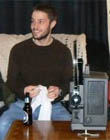|
|
 
|
|
Author
|
Topic: Perf vs Non-perf Screens in Small Rooms
|
Frank Angel
Film God

Posts: 5305
From: Brooklyn NY USA
Registered: Dec 1999
|
 posted 05-07-2009 07:50 PM
posted 05-07-2009 07:50 PM





I am upgrading video at home and want to replace an existing 4:3 screen with a larger 16:9. With the old setup the speakers sat on either side of the screen but right up against the side walls. Now with the extra width, I am going to need to use a perf screen and put the speakers behind it.
Is there any rule-of-thumb as to how big a perf screen would need to be and how far from the screen would you have to be sitting in order for the perfs not to be visible? I would hate to have a perf screen cut to size only to find out that I will be treating my family and friends to what will look like a movie covered with pokadots.
I know there are micro perfs, but even with those, there has to be some sort of formula worked out as to how visible those holes would be from any given distance, assuming 20/20 vision, not to mention the damn effect.
Is the moiré thing predictable if one knows the rez of the projector, the chip size, the screen size and the hole size -- seems the math guys should be able to predict what the relationship of those parameters would have to be to avoid moiré patterns.
On the other hand, I was looking for this strange screen material that I came across years ago -- it was a very elastic fabric material, quite thin, which could be stretched in all directions and which you stretched tight over a frame. The surface of the fabric was very reflective. At the time I recall it was claimed that it needed no perfs because sound could penetrate the material without uneven attenuation of the spectrum, or at least nothing that couldn't be voiced out with standard 1/3rd octave eq. At least with this approach you wouldn't need to worry about seeing dots on your screen. But as old memeory would have it, I can't remember who manufactured it or what it was called. This would probably be a better solution rather than messing with a perf screen in a small room where kids tend to sit on the floor and get pretty up an personal with the screen.
| IP: Logged
|
|
|
|
|
|
Julio Roberto
Jedi Master Film Handler
Posts: 938
From: Madrid, Madrid, Spain
Registered: Oct 2008
|
 posted 05-08-2009 12:37 AM
posted 05-08-2009 12:37 AM



I would also try to make it non-perf. Test to see if the sound is ok and can be eq'ed or the speakers can be well placed.
Woven fabric screens can indeed color the sound the same or less than micro perfs, so they are also a good option. They would usually provide a decrease brightness and contrast (by about 30%, let's say) compared to your average micro-perf matte screen (usually less than 1.1 gain).
This is a manufacturer (not endorsed by me):
http://www.screenexcellence.com/screen-fabrics
If you must go with a perforated one, and you'll be sitting close to the screen (say less than 2 screen heights), get the smallest perforations from your choice of manufacturers. The micro-perfs usually cover 5%-8% of the surface, thus decrease brightness by about that much (compared to non-perf). You usually can not see most micro-perfs from between 12 to 15 feet (when the screen is lit at 12ft).
Most manufacturers advise placement of speakers a foot or so behind the screen the micro-perfs and never less than 4".
If you are suspecting you might get a moiré pattern (can be calculated but it's actually just better to test for it, it's rare with today's projector's fill factors and high-res), just get your screen slightly larger so you can mount it at a degree offset from vertical (i.e. the holes not running perfectly vertical/horizontal). Start trying placing it 1º and increase 1º at the time until the moiré is gone, usually before you hit 25º. You can also get the screen already cut at an offset from some manufacturers, so ask. Moiré is rare from HD home projectors on screens over 125" wide.
| IP: Logged
|
|
|
|
|
|
|
|
|
|
|
|
|
|
Julio Roberto
Jedi Master Film Handler
Posts: 938
From: Madrid, Madrid, Spain
Registered: Oct 2008
|
 posted 05-08-2009 03:11 PM
posted 05-08-2009 03:11 PM



Of course, we are talking in general terms here. Each manufacturer's perf and micro-perf screens are different in hole size and separation. Some manufacturer's regular perf size can be as small as some other's micro-perf.
The size and distance of the perfs is absolute, and thus, the distance at which they become virtually invisible doesn't depend on the screen size etc (except that one usually looks at a larger screen from farther away). One screen height on a 80" screen will reveal perfs on the same material than one screen height at a 180" screen ![[Wink]](wink.gif) But they would both be invisible at about 15' or a bit less. But they would both be invisible at about 15' or a bit less.
The distance at which they will become invisible would depend on your eyesight, eyeball size (children's are significantly smaller ![[Wink]](wink.gif) ), contrast ratio (i.e. screen illuminance, ambient light, how dark it is behind the perforations...) etc, etc. ), contrast ratio (i.e. screen illuminance, ambient light, how dark it is behind the perforations...) etc, etc.
After about 15 feet, I'd say no normal person would see them under most circunstances on any screen I know of. After 12 feet, most micro-perfs are invisible to most under most circunstances. Less than that, and it would depend on your particular screen/set of eyes/lighting conditions. You should start trying to get the perfs as small as possible at shorter distances than this.
Moiré is always possible. Its prediction a mathematical nightmare based on the tiniest tolerances of the involved parameters.
http://www.optics.arizona.edu/jcwyant/optics513/chapternotes/chapter04/moirechaptersecured.pdf
But generally, on today's HD projectors (which have high pixel fill factors and high pixel density) and on large screens (125" wide or more), they would be rare to appear. But they CAN appear at ANY size and ANY projection distance with ANY projector currently manufactured. It's a matter of "luck" to hit a sweet spot frequency combination. The smaller the screen width, the more likely to appear. Under 80" or so and the probability is quite large with the sizes of current (micro) perfs. You'll pbbly get it and will have to deal with it to minimize it.
It's better to just test for it. Some screen manufacturers may have already tested a particular projector and they can cut a screen with an angle offset optimal to reduce the moiré in your particular case/projection distance. Otherwise, it's just sort of trial-and-error, which is the best route anyway, when practical i.e. a screen not-too-large with extra material that can be "hidden" behind the screen frame and thus easily rotated.
Or just go with woven screens and the likeness of moire on any largish screen is low and they can also be adjusted even more easily. With woven screens, it's important to have the back of the "room" as dark as possible, and even the back surface of the fabric should be ideally black. If sound can come forward, that means that tons of light can go behind the screen, reflect, and come back out.
Also, the inter-fabric reflections will lower constrast. How much, will depend on each particular screen. Perhaps as much as 30% in some cases. "Brightness" is also usually low on these screens. While most matted micro-perfs will be less than 1.1 gain and the perfs lose 5-8% of the light, woven can lose as much as 12% and have gains usually lower than 0.9, which can result in screens as "dark" as 0.8. Some are "high gain" (reduced angle of vision to about 120º) to compensate for the loss.
Here are another guys selling woven (once again, not endorsed by me, I don't have enough experience with woven screens):
http://www.smxscreen.com/index.html
| IP: Logged
|
|
|
|
|
|
All times are Central (GMT -6:00)
|
|
Powered by Infopop Corporation
UBB.classicTM
6.3.1.2
The Film-Tech Forums are designed for various members related to the cinema industry to express their opinions, viewpoints and testimonials on various products, services and events based upon speculation, personal knowledge and factual information through use, therefore all views represented here allow no liability upon the publishers of this web site and the owners of said views assume no liability for any ill will resulting from these postings. The posts made here are for educational as well as entertainment purposes and as such anyone viewing this portion of the website must accept these views as statements of the author of that opinion
and agrees to release the authors from any and all liability.
|

 Home
Home
 Products
Products
 Store
Store
 Forum
Forum
 Warehouse
Warehouse
 Contact Us
Contact Us




 Printer-friendly view of this topic
Printer-friendly view of this topic







![[Frown]](frown.gif)



![[Wink]](wink.gif) But they would both be invisible at about 15' or a bit less.
But they would both be invisible at about 15' or a bit less.![[Smile]](smile.gif)



